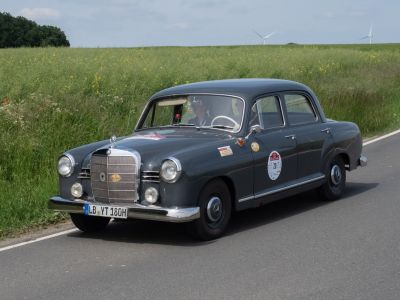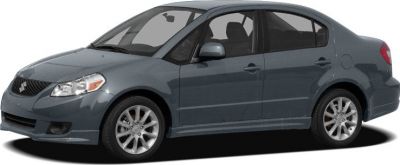 1956 Mercedes-Benz W121 Sedan Dimensions, Size & Specs
1956 Mercedes-Benz W121 Sedan Dimensions, Size & SpecsMeasurements of the 1956 Mercedes-Benz W121 Sedan, engineered for optimal performance and comfort
| Dimensions | |
|---|---|
| Length: | 4485 mm176.6 in14.7 ft |
| Width: | 1740 mm68.5 in5.7 ft |
| Height: | 1560 mm61.4 in5.1 ft |
| Weight Specifications | |
| Curb Weight: | 1200-1210 kg2646-2668 lbs |
| Maximal permitted Weight: | 1650-1660 kg3638-3660 lbs |
The Mercedes-Benz Ponton W121 Sedan, produced between 1956 and 1959, represents a pivotal model in Mercedes-Benz's mid-20th century portfolio, well-known for its balanced blend of luxury, engineering, and classic design. This model embodies the automotive style of the era, featuring a sedan body type with dimensions that suited both urban driving and comfortable long-distance travel.
In terms of size, the Ponton W121 Sedan measures 4485 mm (176.6 inches) in length, 1740 mm (68.5 inches) in width, and stands 1560 mm (61.4 inches) tall. These proportions give the vehicle a solid presence on the road while maintaining agility suitable for the roads and parking conditions of the 1950s. Its exterior dimensions reflect the design priorities of the period, with a slightly more compact footprint compared to larger contemporary luxury sedans, yet providing ample interior space for passengers.
Weighing in with a curb weight between 1200 and 1210 kilograms (approximately 2645 to 2668 pounds), the Ponton W121 balances weight and performance carefully. Its maximum weight ranges from 1650 to 1660 kilograms (3638 to 3661 pounds), defining the structural and mechanical limits in terms of load and passenger capacity. This weight is reflective of the sturdy build quality typical of Mercedes-Benz vehicles, ensuring durability and reliability.
The W121 model's design and engineering reflect a transition era for Mercedes-Benz, maintaining traditional craftsmanship while embracing mid-century automotive advances. Its size and weight parameters make it a historically significant car that balanced luxury with practicality during its production years. The Ponton W121 remains a valued classic, admired for its timeless design and well-rounded specifications that highlight the evolution of mid-century sedans under the Mercedes-Benz marque.
Discover the standout features that make the 1956 Mercedes-Benz W121 Sedan a leader in its class
Have a question? Please check our knowledgebase first.
The Mercedes-Benz Ponton W121 Sedan, produced from 1956 to 1959, measures 4485 mm (176.6 inches) in length, 1740 mm (68.5 inches) in width, and stands 1560 mm (61.4 inches) tall. These dimensions classify it as a mid-sized sedan for its era, offering a balance between interior space and manageable exterior size. The car's dimensions reflect the design trends of the 1950s, focusing on streamlined shapes while maximizing passenger comfort.
The W121's width is 1740 mm (68.5 inches) and height is 1560 mm (61.4 inches), which comfortably fits within the standard single-car garage dimensions. Typically, modern garages measure about 2440 mm to 3050 mm (8 to 10 feet) wide and have a height clearance over 2000 mm (6.5 feet). Therefore, parking the Ponton W121 inside a standard garage is generally hassle-free, with ample room for door opening and maneuvering around the vehicle.
The curb weight of the Mercedes-Benz Ponton W121 Sedan varies slightly between 1200 kg and 1210 kg (2646 to 2670 lbs), while its maximum permissible weight ranges from 1650 kg to 1660 kg (3638 to 3657 lbs). This relatively moderate weight for a mid-1950s sedan contributes to its manageable driving characteristics, efficient fuel consumption for the era, and balanced handling dynamics.
Compared to the predecessor Mercedes-Benz W120 (another Ponton model), the W121 Sedan at 4485 mm (176.6 inches) is slightly longer by approximately 50-60 mm (around 2.0-2.4 inches). This subtle increase reflected the evolution in design towards offering more interior space and a more substantial road presence. Overall, while maintaining the classic Ponton styling, the W121 provided a slightly more refined and spacious experience compared to its predecessor.
The W121 Ponton Sedan fell within the typical mid-sized sedan category of the 1950s. For comparison, the 1956 BMW 503 Coupe and Sedan measured roughly similar lengths around 4600-4700 mm (181-185 inches), but were wider and heavier. American sedans like the 1956 Chevrolet Bel Air were substantially longer, often exceeding 5000 mm (197 inches). Thus, the W121 offered a more compact German luxury alternative, balancing elegant design with urban practicality compared to larger American sedans and other European competitors.
The interior of the W121 Ponton Sedan was designed to comfortably seat four to five passengers with ample headroom and legroom for a car of its size and era. Thanks to its dimensions (4485 mm length and 1740 mm width), the cabin provides a cozy yet efficient space layout, emphasizing quality materials and craftsmanship typical of Mercedes-Benz. The seating was often upholstered in quality fabrics or leather, and the build provided a quiet, smooth ride, making it suitable for daily commuting or longer journeys during the 1950s.
Yes, the W121's dimensions (4485 mm length and 1740 mm width) make it relatively easy to maneuver and park in today's urban environments compared to larger modern vehicles or classic cars with bigger footprints. Despite its vintage mechanicals and design, its modest size allows it to fit into typical parking spaces comfortably, making it practical for enthusiasts who want to drive a classic car without facing excessive spatial challenges in modern cities.
With a curb weight between 1200 kg and 1210 kg (2646-2670 lbs) and a typical front-engine, rear-wheel-drive layout, the W121 Ponton Sedan offered balanced and predictable handling. Its weight distribution contributed to stable driving dynamics, with a focus on comfort rather than sportiness. The car’s suspension and chassis design provided a smooth ride quality consistent with Mercedes-Benz’s reputation for engineering refinement during the 1950s.
The W121 Ponton Sedan definitely fits into a standard home garage. With a length of 4485 mm (176.6 inches), width of 1740 mm (68.5 inches), and height of 1560 mm (61.4 inches), it comfortably fits inside traditional single-car garages, which are typically designed to accommodate vehicles up to around 4900 mm (193 inches) in length and over 2000 mm (79 inches) in height. This means owners of this classic sedan can safely store their vehicle in usual home garages without spatial concerns.
The W121 Ponton Sedan, produced from 1956 to 1959, succeeded the earlier W120 model. Dimensionally, the W121 is slightly longer at 4485 mm (176.6 in) versus the W120’s approximate 4420 mm (174 in), providing increased cabin space. The W121 also featured subtle design refinements including smoother body lines and upgraded mechanical components aimed at better performance and comfort. Compared to the W120, the W121 balanced traditional Ponton styling with enhanced road manners and modernized features suitable for late 1950s luxury car buyers.
Discover similar sized cars.

| Production: | 2015-2018 |
|---|---|
| Model Year: | 2015 |
| Length: | 4425 mm174.2 in |
| Width: | 1695 mm66.7 in |
| Height: | 1505 mm59.3 in |

| Production: | 2012-2017 |
|---|---|
| Model Year: | 2012 |
| Length: | 4425 mm174.2 in |
| Width: | 1695 mm66.7 in |
| Height: | 1505 mm59.3 in |

| Production: | 2010-2016 |
|---|---|
| Model Year: | 2010 |
| Length: | 4452 mm175.3 in |
| Width: | 1705 mm67.1 in |
| Height: | 1480 mm58.3 in |

| Production: | 2017-2019 |
|---|---|
| Model Year: | 2017 |
| Length: | 4440 mm174.8 in |
| Width: | 1695 mm66.7 in |
| Height: | 1495 mm58.9 in |

| Production: | 1959-1961 |
|---|---|
| Model Year: | 1959 |
| Length: | 4500 mm177.2 in |
| Width: | 1740 mm68.5 in |
| Height: | 1560 mm61.4 in |

| Production: | 1959-1962 |
|---|---|
| Model Year: | 1959 |
| Length: | 4500 mm177.2 in |
| Width: | 1740 mm68.5 in |
| Height: | 1560 mm61.4 in |

| Production: | 2007-2009 |
|---|---|
| Model Year: | 2007 |
| Length: | 4490 mm176.8 in |
| Width: | 1730 mm68.1 in |
| Height: | 1545 mm60.8 in |
